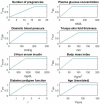A Fuzzy Rule-Based System for Classification of Diabetes
- PMID: 34884099
- PMCID: PMC8659829
- DOI: 10.3390/s21238095
A Fuzzy Rule-Based System for Classification of Diabetes
Abstract
Diabetes is a fatal disease that currently has no treatment. However, early diagnosis of diabetes aids patients to start timely treatment and thus reduces or eliminates the risk of severe complications. The prevalence of diabetes has been rising rapidly worldwide. Several methods have been introduced to diagnose diabetes at an early stage, however, most of these methods lack interpretability, due to which the diagnostic process cannot be explained. In this paper, fuzzy logic has been employed to develop an interpretable model and to perform an early diagnosis of diabetes. Fuzzy logic has been combined with the cosine amplitude method, and two fuzzy classifiers have been constructed. Afterward, fuzzy rules have been designed based on these classifiers. Lastly, a publicly available diabetes dataset has been used to evaluate the performance of the proposed fuzzy rule-based model. The results show that the proposed model outperforms existing techniques by achieving an accuracy of 96.47%. The proposed model has demonstrated great prediction accuracy, suggesting that it can be utilized in the healthcare sector for the accurate diagnose of diabetes.
Keywords: classification; diabetes; diabetes prediction; fuzzy logic; fuzzy rule-based system.
Conflict of interest statement
The authors declare no conflict of interest.
Figures






Similar articles
-
Development of a Reinforcement Learning-based Evolutionary Fuzzy Rule-Based System for diabetes diagnosis.Comput Biol Med. 2017 Dec 1;91:337-352. doi: 10.1016/j.compbiomed.2017.10.024. Epub 2017 Oct 31. Comput Biol Med. 2017. PMID: 29121541
-
Early prediction of radiotherapy-induced parotid shrinkage and toxicity based on CT radiomics and fuzzy classification.Artif Intell Med. 2017 Sep;81:41-53. doi: 10.1016/j.artmed.2017.03.004. Epub 2017 Mar 18. Artif Intell Med. 2017. PMID: 28325604
-
Multi-objective evolutionary algorithms for fuzzy classification in survival prediction.Artif Intell Med. 2014 Mar;60(3):197-219. doi: 10.1016/j.artmed.2013.12.006. Epub 2014 Jan 9. Artif Intell Med. 2014. PMID: 24525210
-
Improved Cattle Disease Diagnosis Based on Fuzzy Logic Algorithms.Sensors (Basel). 2023 Feb 13;23(4):2107. doi: 10.3390/s23042107. Sensors (Basel). 2023. PMID: 36850710 Free PMC article. Review.
-
Fuzzy Classification Methods Based Diagnosis of Parkinson's disease from Speech Test Cases.Curr Aging Sci. 2019;12(2):100-120. doi: 10.2174/1874609812666190625140311. Curr Aging Sci. 2019. PMID: 31241024 Review.
Cited by
-
Antidiabetic, antidyslipidemia, and renoprotector potency of butterfly pea flower extract (Clitorea ternatea L.) in diabetes mellitus and dyslipidemia rats model.Open Vet J. 2024 May;14(5):1135-1145. doi: 10.5455/OVJ.2024.v14.i5.7. Epub 2024 May 31. Open Vet J. 2024. PMID: 38938424 Free PMC article.
-
Prediction of the Age and Gender Based on Human Face Images Based on Deep Learning Algorithm.Comput Math Methods Med. 2022 Aug 24;2022:1413597. doi: 10.1155/2022/1413597. eCollection 2022. Comput Math Methods Med. 2022. PMID: 36060657 Free PMC article.
-
Comparative Study of Fuzzy Rule-Based Classifiers for Medical Applications.Sensors (Basel). 2023 Jan 15;23(2):992. doi: 10.3390/s23020992. Sensors (Basel). 2023. PMID: 36679786 Free PMC article.
References
-
- IDF Diabetes Atlas 9th Edition. 2021. [(accessed on 11 August 2021)]. Available online: https://diabetesatlas.org/en/
MeSH terms
Grants and funding
LinkOut - more resources
Full Text Sources
Medical

